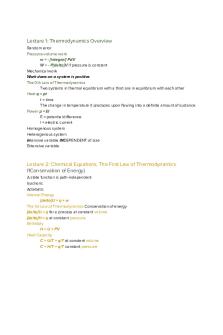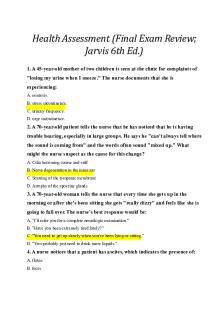Final exam review summaries (Chapter 14) PDF

| Title | Final exam review summaries (Chapter 14) |
|---|---|
| Course | Introductory Biology |
| Institution | Ohio State University |
| Pages | 2 |
| File Size | 55.2 KB |
| File Type | |
| Total Downloads | 50 |
| Total Views | 124 |
Summary
chapter 14 summary and take home message...
Description
14.1 What is ecology? TAKE-HOME MESSAGE 14.1: Population ecology is the study of the interactions between populations of organisms and their environments, particularly their patterns of growth and how they are influenced by other species and by environmental factors. 14.2 A population perspective is necessary in ecology. TAKE-HOME MESSAGE 14.2: Most ecological processes cannot be observed or studied within an individual. Rather, we need to consider the entire group of individuals that regularly exchange genes in a particular locale. 14.3 Populations can grow quickly for a while, but not forever. TAKE-HOME MESSAGE 14.3: Populations tend to grow exponentially, but this growth is eventually limited. 14.4 A population’s growth is limited by its environment. TAKE-HOME MESSAGE 14.4: A population’s growth can be constrained by densitydependent factors: as density increases, a population reaches the carrying capacity of its environment, and limited resources put a ceiling on growth. It can also be reduced by densityindependent factors such as natural or human-caused environmental calamities. 14.5 Some populations cycle between large and small. TAKE-HOME MESSAGE 14.5: Although the logistic growth pattern is better than any other model for describing the general growth pattern of populations, some populations cycle between periods of growth and rapid shrinkage. 14.7 Life histories are shaped by natural selection. TAKE-HOME MESSAGE 14.7: An organism’s investment pattern in growth, reproduction, and survival is described by its life history. Very different strategies can achieve the same outcome in which a mating pair of individuals produces at least two surviving offspring. 14.8 There are trade-offs between growth, reproduction, and longevity. TAKE-HOME MESSAGE 14.8: Because constraints limit evolution, life histories are characterized by trade-offs between investments in growth, reproduction, and survival. 14.14 Age pyramids reveal much about a population. TAKE-HOME MESSAGE 14.14: Age pyramids show the number of individuals in a population within any age group. They allow us to estimate birth and death rates over multi-year periods. 14.15 As less-developed countries become more developed, a demographic transition often occurs. TAKE-HOME MESSAGE 14.15: The demographic transition tends to occur with the industrialization of countries. It is characterized by an initial reduction in the death rate, followed later by a reduction in the birth rate. 14.16 Human population growth: How high can it go? TAKE-HOME MESSAGE 14.16: The world’s human population is currently growing at a very high rate, but limited resources will eventually limit this growth, most likely at a population size between 7 and 11 billion....
Similar Free PDFs

Case summaries final exam
- 33 Pages

Final Exam Review Chapter 15
- 2 Pages

Exam chapter-14-, answers
- 25 Pages

Exam View - Chapter 14
- 3 Pages

HR Final Exam Chapter 6-9 review
- 3 Pages

Chem Final Exam Review
- 12 Pages

Final Exam - Review notes
- 92 Pages

Bio Final Exam Review
- 2 Pages

Final EXAM Review booklet
- 5 Pages

CHEM303 final exam review
- 4 Pages

Psychology Final Exam - Review
- 13 Pages

Jarvis Final Exam Review
- 12 Pages
Popular Institutions
- Tinajero National High School - Annex
- Politeknik Caltex Riau
- Yokohama City University
- SGT University
- University of Al-Qadisiyah
- Divine Word College of Vigan
- Techniek College Rotterdam
- Universidade de Santiago
- Universiti Teknologi MARA Cawangan Johor Kampus Pasir Gudang
- Poltekkes Kemenkes Yogyakarta
- Baguio City National High School
- Colegio san marcos
- preparatoria uno
- Centro de Bachillerato Tecnológico Industrial y de Servicios No. 107
- Dalian Maritime University
- Quang Trung Secondary School
- Colegio Tecnológico en Informática
- Corporación Regional de Educación Superior
- Grupo CEDVA
- Dar Al Uloom University
- Centro de Estudios Preuniversitarios de la Universidad Nacional de Ingeniería
- 上智大学
- Aakash International School, Nuna Majara
- San Felipe Neri Catholic School
- Kang Chiao International School - New Taipei City
- Misamis Occidental National High School
- Institución Educativa Escuela Normal Juan Ladrilleros
- Kolehiyo ng Pantukan
- Batanes State College
- Instituto Continental
- Sekolah Menengah Kejuruan Kesehatan Kaltara (Tarakan)
- Colegio de La Inmaculada Concepcion - Cebu



